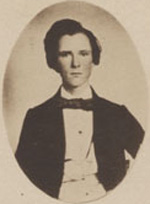 |
Major Dowell Sterrett. Columbiana AL. Born June 27, 1840 near Columbiana, Shelby County, Alabama. Parents, Judge Alfonso A. Sterrett and Elizabeth M. Gooch. Attended a military school at Camden, Alabama, according to one source. Went to University of Alabama in 1857 as a freshman per its alumni register, but transferred to Howard College, Marion, Alabama that same year, and is listed as a freshman in the 1857-1858 catalogue. Initiated by Mu Chapter as a freshman, reportedly in February 1858, although such dates from the fraternity catalogues are often suspect. Suspended for participating in a duel. Transferred to UVA and appears in the 1858-1859 and 1859-1860 catalogues. He served as Legate (installing officer) of Omicron Chapter, and as chapter president. Roomed with Jones at some point. Studied medicine at Selma, Alabama with Dr. P. H. Cabel. Raised a Master Mason in 1861; also was active in the Missionary Baptist Church and was an Odd Fellow. Enlisted at Selma, April 10, 1861; private, lieutenant, captain, Co. C, 4th Alabama Infantry. Wounded at Antietam, September 17, 1862, from which he lost a leg, and was promoted to major. Declared unfit for field duty, he was made a quartermaster in Alabama. Licensed to practice medicine by Shelby County, 1864, following study with Dr. J. C. Blake in Columbiana Co. M.D. and valedictorian, Atlanta Medical College, 1866. Moved to Grand Bluff, Panola County, Texas that year. Married January 20, 1870 to S. Julia Vawter at Marshall, Texas. Later lived in Beckville, Texas. Moved to Confederate Home in Austin in 1908. Died October 24, 1919 at Austin TX. See related article about his badge, with photos.
Freeman, Terah M. "Dr. Major Dowell Sterrett." Confederate Veteran, November 1920, page 430.
Daniell, Lewis E. Types of Successful Men of Texas (Austin: Eugene Von Boeckmann, 1890), pages 235-236.
Owen, Thomas McAdory. History of Alabama and Dictionary of Alabama Biography, Volume 4 (Chicago: The SJ Clarke Publishing Co., 1921), pages 1620-1621.
|
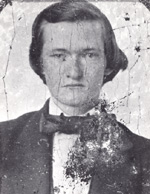 |
John Thomas Jones. Carollton, Alabama. Born February 16, 1840, Wilcox County, Mississippi, son of Thomas Jones Jr, a planter. Family moved to Pickens County, Alabama in October 1840. At 13, joined Big Creek Baptist Church. Attended University of Alabama from 1856 to 1858, departing as a sophomore. Attended UVA 1858 to 1860, rooming with Sterrett at one point. He apparently departed early; the letter in Sterret's book refers to "this that last day, perhaps, which I shall ever spend at the University" and is dated May 29th, 1860, whereas commencement was some weeks later. The 1860 census places him back in Carrollton with his parents, occupation student; presumably he was studying law. Opened law office, Carrollton, Alabama, 1860. Enlisted as a private in 1861 in Co. C, 5th Alabama Infantry. Killed in a charge at Gaines Mill (First Cold Harbor), June 27, 1862. Buried on the battlefield. Despite what The University Memorialsays, if he was interred where he fell, the grave may have been obliterated during the 1864 battle, or moved during the Union's post-war recovery of bodies on that battlefield.
(Note: Sterret's obituary in Confederate Veteran(see above) says, "On entering the University of Virginia he met there two other Phi Gams, Major T. William Jones, of Marion, Ala., and T. Major Freeman, of Kentucky." This appears to be an error in recalling Jones's name, what with the passage of sixty years. Jones is not listed on the rolls of the Howard or Alabama chapters, nor is any other Jones on the membership roll who fits the name Freeman gives.)
|
| |
Charles Gachet. Enon, Macon Co. [now Bullock Co.], Alabama. Born in Georgia, June 16, 1838 to James E. Gachet and Lavinia Harrison Jones. Attended University of Alabama as a freshman in 1856-57. Transferred to UVA, attending 1857 and 1858. Chapter treasurer, according to the Unfinished Catalogue. Expelled from UVA for a duel in October 1859 (indicated by the letter to Sterrett, contradicting another source that says says he was expelled June 9th). His farewell letter also gives his hometown as Chunnenuggee Ridge. The 1860 census places him with his parents, planters in Macon County, Alabama. 1st Sergeant, Co. C, 3rd Alabama Infantry. Married Tallulah Kate Lumpkin, February 22, 1871. Later a merchant in Auburn, Alabama, but by 1910 census widowed and living in Memphis with his daughter's family.
|
| |
Thaddeus Clement Watts. Greenville, Alabama. Born September 30, 1839 to John Hughes Watts and Prudence Hill. Attended the University of Alabama 1856-1859 (according to the 1901 register), departing as a sophomore. Attended UVA in 1858 (note the discrepancy with Alabama's register). Married Mary Carter, February 23, 1860 in Pine Flat, Butler County; the census that July places them there with his mother, a farmer. Enlisted with 44th Alabama Infantry in 1862 as a sergeant. Discharged at the end of the year for a substitute. 1870 census places him in Greenville, Butler Co., employed as a bookkeeper. Married Evelyn Williams, September 24, 1878. 1880 census shows him a farmer in Fox Mills, Wilcox Co. University Register says a merchant in Greenville, died December 2, 1882; however, his gravestone says died December 1, 1881. Buried Oak Hill Cemetery/Ebenezer Methodist Cemetery, Oak Hill, Alabama.
|
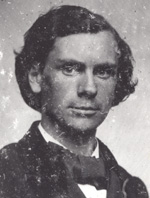 |
Terah Major Freeman. Frankfort, Franklin Co., Kentucky. Born April 5, 1839 in Kentucky, son of farmers Martha and Dandridge Freeman (according to the 1850 census). Attended Bethel College, where he was a charter member of the Nu Chapter in 1856 and served as its treasurer. Went to UVA in 1858. Chapter secretary according to fraternity catalogues. Suspended from the University for seconding Charles Gachet (see above) during his duel in October, 1859. Went to Harvard, earning a LL.B. in 1860. Enlisted in Co. B, 2nd Kentucky Infantry; captured at Fort Donelson but escaped. Then adjutant, 4th Kentucky Cavalry, Morgan's Raiders. Shot in the neck (but not "seriously" injured) and captured but again escaped. Traveled to Indiana and Illinois to work with the Sons of Liberty on a plan to free Confederate POWs, but the plan was betrayed. In 1865, served with Co. A, 7th Battalion Kentucky Mounted Infantry (Bart Jenkin's Cavalry.). At some point he was made captain. Died at the Confederate Home in Austin, Texas, January 19, 1927.
Trimpi, Helen P. Crimson Confederates: Harvard Men Who Fought For the South (Knoxville: The University of Tennessee Press, 2010) pages 86-87.
Mosgrove, George D. Kentucky Cavaliers in Dixie: Reminiscences of a Confederate Cavalryman(Louisville: Courier-Journal Job Printing Co., 1895) pages 112-113.
Freeman, Terah M. "The Sons of Liberty" in Johnson, Adam Rankin, The Partisan Rangers of the Confederate States Army (Louisville: George G. Fetter Co., 1904) pages 428-437.
|
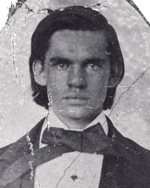 |
Edgar Cephas Rowe. Fredericksburg, Spotsylvania Co., Virginia. Born October 29, 1839 in Virginia to George Rowe and Lucy Leitch; they were a prominent and wealthy family, a Baptist minister who owned a large plantation. Attended Columbian College, Washington, DC as a sophomore in 1855-1856, according to its catalogue of that year. (Columbian is known as George Washington University today. He is not shown as a graduate in their 1891 Historical Catalogue of the Officers and Graduates.) Rowe attended UVA from at least 1858 to June 1860, the latter date determined by his letter in Sterret's book. The 1860 census puts him in Fredricksburg with his parents, a student of law. Married Emily Sledd of Richmond on November 14, 1860. His obituary in The Virginia Starnewspaper (February 22, 1904) says: "He was in the Confederate service as a cavalryman early in the war, and later transferred to the quartermaster's division and had charge of Federal prisoners on Belle Isle, at Richmond." This is uncertain; the NPS database indicates Edgar C. Rowe was a private in the 55th Virginia Infantry. The 1870 census gives his occupation as lawyer. His obituary continues, "Early in the seventies he held a clerkship in the United States House of Representatives at Washington, and later was a clerk in the Senate of Virginia. In 1877 he was appointed to the US Railway mail service and assigned to duty on the P F & P R R (Narrow Gauge) between this city and Orange C H which position he held consecutively until his death." He died February 12, 1904, a few days after having a stroke.
|
| |
Charles Thomas Pelham. Austin, Texas. Born February 28, 1837 in Arkansas to General William Pelham and Mary Ann Pelham. 1850 census places them in Victoria Co., Texas. Attended Baylor University 1857-1859. Transferred to UVA. While he is not shown on the rolls of the chapter, a letter by Pelham in Sterret's autograph book confims that he associated with them. The letter, dated March 8, 1860, indicates Pelham's imminent departure (with no reason given), and gives his residence as Austin. The 1860 census shows him farming with his mother in Travis County, Texas. Private in Co. D, 8th Texas Cavalry; according to the Terry's Texas Rangers website, mustered in September 7, 1861 in Houston, captured once and exchanged. "Charles T. Pelham was indeed the hero of every engagement in which he was an actor. He leveled his pistol like firing at a target, and died in the front of a cavalry charge in Northern Georgia, in the spring of '64. His aged father and mother, grieving at the loss of their only son, asked the Texas Legislature to change the name of a beloved grandson, Charles Pelham Ten Eyck, to Charles T. Pelham, which was done." [Confederate Veteran, Vol. 2, No. 7 (July 1894), p. 219. Ten Eyck's middle name may be incorrect in this account.] Pelham was killed near Dalton, Georgia, May 9, 1864. Buried with his parents in Oakwood Cemetery, Austin, Texas.
There are numerous errors on the internet regarding Pelham, including the dates of his and his father's lives. Confederate Veteranerroneously stated he changed his name from Ten Eyck to Pelham to enlist. The aforementioned July 1894 article corrected this, but the error has been perpetuated in one of Webb Garrison's books.
|
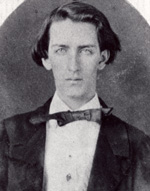 |
Luther Rice Bell. Oxford, North Carolina. Born February 3, 1842. Attended UVA in 1858-1859, and transferred to the University of North Carolina. Refounded Epsilon Chapter in November, 1859, and served as chapter president. Joined the Philanthropic Literary Society in 1859. Vice president c. 1860, Young Men's Christian Association. Graduated with A.B. degree, 1861. Enlisted May 5, 1861 as a private, Co. D, 12th North Carolina Infantry. Killed at Malvern Hill, July 1, 1862. Buried at Old Oxford Cemetery, Oxford, North Carolina.
"....at college was known as a most gentle, amiable and kindly man, sensitive and delicate to a fault, retiring and modest; to the surprise of all, however, he enlisted in the Confederate service in the 7th [sic] North Carolina Regiment, and he proved himself to be a most daring, hearty and courageous soldier, meeting his death at the battle of Malvern Hill by a bullet through the head." "Phi Gamma Delta War Retrospects," The Phi Gamma Delta Quarterly, Vol. 14 No. 4 (October 1892), page 273.
|
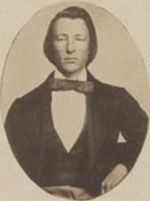 |
Obadiah Pearson Amacker. Tangipahoa, Louisiana. Born December 17, 1838, St. Helena Parish, Louisiana, to Nathaniel Amacker and Mosilla Pearson. Attended UVA 1858-1860, then studied law in New Orleans. Enlisted in May 1861; Sergeant, Co. G "Beaver Creek Rifles", 4th Louisiana Infantry. Company transferred in May, 1862 to Wingfield's 9th Battalion Partisan Rangers, becoming Co. E; Amacker was elected captain. Captured at Port Hudson July 9, 1863. Held at Johnson's Island, and exchanged in 1864. Married Abigail Means Kent in September 1864. Unit redesignated 3rd Louisiana Cavalry (Wingfields); Amacker promoted to Lt. Colonel. Surrendered at Gainesville, Alabama, May 1865. Practiced law in Greensburg, Louisiana. President of St. Helena Parish school directors c. 1870. Ran for judge in Tangipahoa, 1879. Louisiana state senator, 1890-1892. Served on the parish board of supervisors of elections, and was Tangipahoa Parish superintendent of education. Chairman of deacons at his Baptist church in Osyka, Mississippi, on the state border. Died June 17, 1910. Buried at Woodland Cemetery, Kentwood, Louisiana. Grandson was Clayton Miller Amacker, Sr. (Texas 1938). Family papers are in Special Collections, Hill Memorial Library, Louisiana State University; finding aid contains a biography.
|
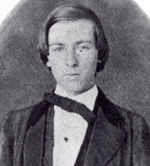 |
Louis Magoon Rogers. Pungoteague, Accomack Co., Virginia. Born February 11, 1841 at Accomack Co., Virginia, to Margaret J. W. Moore and George S. Rogers, farmers. Sent to Richmond College in October 1855. Attended UVA 1858 to 1860. A fellow student wrote, "...he was known as a student. Modest and retiring to a fault, he was yet earnest and faithful in the discharge of his collegiate duties. His manners were gentle, easy, and natural, his mind sound and vigorous, and his life and character singularly pure." Departed the occupied Eastern Shore to join Co. F, 46th Virginia Infantry, August 24, 1862.* Deeply religious, Rogers frequently wrote his mother about his habits of prayer and study. In 1863 General Wise appointed him chief clerk to the brigade adjutant-general's office. Rogers later requested to be returned to his company. In 1864 promoted to ensign (regimental flag bearer) with rank of lieutenant. Wounded June 17, 1864 in a charge at Petersburg. An officer wrote: "Out of 281 rank and file in the charge, 133 were killed or wounded. In this heroic band none was cooler, braver, or more chivalrous than Rogers.... He fell with his colors in his hand.... His coolness and daring were the theme of universal praise." Taken to recuperate at Col. Harrison's home in Goochland Co., Virginia, he died August 24, 1864. Quotes and biography from The University Memorial. The Memorial says he is buried "at the graveyard of his ancestors, at Hollybrook, the residence of his father." According to Grave Stones Inscriptions from Lower Accomack County, Virginia(Heritage Books, 1987) Hollybrook Cemetery is just southwest of the routes 609 and 620 intersection. Rogers's fraternity badge is in UVA's Special Collections Library.
*A shocking event may have precipitated Rogers' departure for Confederate service. Richmond's The Daily Dispatch, August 11, 1862, tells of Union soldiers killing a constable in Accomac County, witnessed by Louis Rogers (spelled "Lewis") and his father, who were arrested for saying "to bystanders that they thought they were living under a civil Government, which they had taken the oath to support, but such conduct and such scenes were an outrage on all Government." Read it at http://imls.richmond.edu/d/ddr/.
|
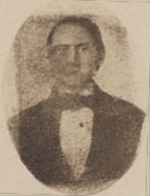 |
Harrison Tillinghast. Marianna, Jackson Co., Florida. Born September 1, 1840 (according to his memorial stone) in Florida to George William Tillinghast and Mary Ann Chapman. The 1850 census shows George as a merchant. Attended UVA in 1859-1860. His parents died before the end of the school year; by the 1860 census his younger siblings are living with Chapman relatives. His activities before the Civil War are uncertain. Enlisted May 10, 1861 at Jackson Co., Florida. 2nd lieutenant in Co. F, 2nd Florida Infantry, becoming 1st lieutenant a year later. Wounded at Seven Pines, May 31, 1862. Missing in action at Sharpsburg/Antietam, September 17th, 1862. Ironically, he was confirmed a captain in October. His body was never recovered but a memorial stone was erected in Riverside Cemetery, Marianna, Florida, apparently many years later.
Hartman, David and Coles, David. Biographical Rosters of Florida's Confederate and Union Soldiers, 1861-1865, Vol. 1 (Broadfoot Publishing Co., 1995), page 189.
|